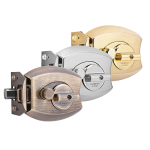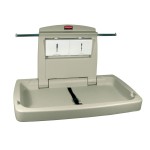This title would have read – Things Your Architect Doesn’t Know Won’t Tell You – because it’s more likely to be true. But I don’t know how to make strike through text in the title. (If you DO know how, be a gem and leave it in the comments!)
Your job is complex – I get it. You deal with a variety of issues every day. You’re sitting at your desk, knee-deep in putting out a fire, then BAM, you get a phone call from one of your district managers with a strange request from an AHJ (Authority Having Jurisdiction) and you’re left scratching your head.
We get these befuddling questions all the time and wanted to share some of the solutions we’ve generated after hours of blood, sweat, tears, and endless googling.
My AHJ is requiring an ADA compliant baby changing station in the restroom of my facility.
We agree, it’s an unusual request, but believe it or not, such a thing exists. Koala makes an ADA compliant baby changing station with an assisted lift. It’s actually pretty cool – the KB208 has a concealed pneumatic cylinder and hinge that provide controlled, slow opening and closing of the bed. When installed properly, it (along with many other Koala baby changers) also meets the requirements for maximum reach, as well as Braille operating instructions.
How can I control access to my restrooms in high-risk areas?
Restroom vagrancy is a common problem, especially in high-risk areas. In fact, I just did a blog post and featured article in our newsletter surrounding this question. In short, the ability to control access to the restroom is paramount to keeping them in clean working order. You may have tried keyed locks, and likely found that the keys kept walking out the door. While this solution has proven successful for some, there are other available options.
After numerous requests for an alternative solution, we created the restroom strike kit, where patrons can be buzzed into the restroom. There are also a variety of digital locks with a privacy function:
Each of these Grade-1, heavy duty locksets have a LED indicator on the front which indicates when the privacy feature is active. Store personnel can provide the code to patrons, and these codes can be changed on a regular interval.
I’m being sued because the partition lock in my ADA compliant restroom stall doesn’t meet ADA standards.
 Most people don’t know that handicap restroom stalls must have ADA compliant locking hardware. In fact, if a stall is large enough to meet ADA standards, the locking hardware must be compliant as well. Without industry knowledge, the difference is barely noticeable; but lack of the correct hardware can result in a hefty fine. If you look at the locks to the left, they seem very similar and they function in the same manner. However, the lock in the top photo is the only one that meets ADA compliance standards. We recommend working with a knowledgeable vendor to ensure you don’t end up in a lurch. Jacknob has a host of ADA compliant options available.
Most people don’t know that handicap restroom stalls must have ADA compliant locking hardware. In fact, if a stall is large enough to meet ADA standards, the locking hardware must be compliant as well. Without industry knowledge, the difference is barely noticeable; but lack of the correct hardware can result in a hefty fine. If you look at the locks to the left, they seem very similar and they function in the same manner. However, the lock in the top photo is the only one that meets ADA compliance standards. We recommend working with a knowledgeable vendor to ensure you don’t end up in a lurch. Jacknob has a host of ADA compliant options available.
Do you have a hardware compliance issue your struggling with? Let us know – we love a challenge.
This article originally appeared in the July edition of The Open Door.
Google


You would need either an elrcteic strike or a maglock installed along with a power supply and a momentary switch of some type. This type of work is best left up to Locksmiths and others who work on access control as it is usually cheaper to get it done right the first time than to call them in to fix it after the fact. Another plus is you should get a job that looks good and works.